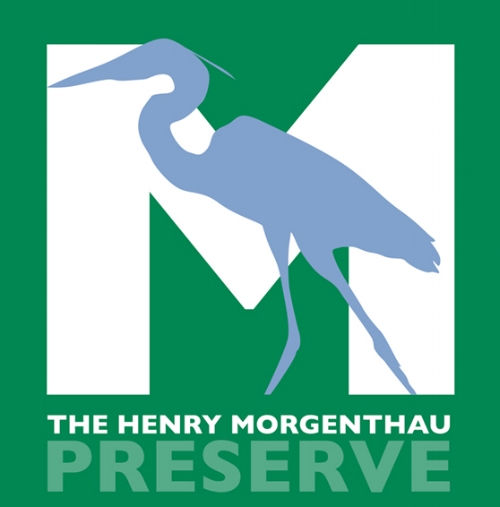Morgenthau Preserve Trail Map
SUGAR MAPLE FOREST
1 These trees are on the Blue Trail just before the Jerome J. Lawton Crossroads. Sugar Maples (Acer Saccharum) are the predominant tree in the preserve and line the paths of the Blue Trail from the entranceof the preserve to the Jerome J. Lawton Crossroads. They are identified by five-lobed leaves and paired, winged seeds, which are eaten extensively by many kinds of wildlife.
OAK-HICKORY FOREST
12 Continue on the southern route of the Blue Trail and cross the White trail. Soon you will observe a large Black Oak (Quercus velutina) on your left. It is one of several Oak species found in the preserve. Its pointed, shallow-cut leaves and dark, block-like bark distinguish it from the White Oak. Its extensive root system and dense wood allow Black Oaks to withstand winds and heavy snow that may topple less hardy species. These tall trees sometimes grow to 75 ft. high.
11 Continue following the Blue Trail, to the Shagbark Hickory (Carya ovata) trees. They are identified by flaking, shaggy bark that curves outward at the top and bottom and scales off in long thin plates. The compound leaves are set alternately upon the twig. In September the tree produces a crop of sweet, egg shaped nuts with four-parted husks that are eaten by squirrels, turkey and deer.
4 Dominating the landscape on the Yellow Trail is a massive White Oak (Q. alba). Naturalists estimate the tree’s age at 400 years old, which makes it one of the oldest Oaks in Westchester County! It is noted for its ash-gray flaking bark and light green, evenly round-lobed leaves. Oaks of this type are referred to as “Wolf Oaks” and you will observe several of these oaks growing in ornear stonewalls. They thrive alone in open spaces where the tree’s broad crown can develop a majestic appearance. The presence of a Wolf Oak usually indicates the land was once used for pasture and crops.
RED MAPLE SWAMPS
3 The Red Maple (Acer rubrum) is the dominant tree species found in the swamps along the Yellow Trail. These trees can thrive in a variety of adverse conditions and occur in many types of hydro-geological settings. Red Maple Swamps are the most abundant type of freshwater wetland throughout the Northeast and flourish due to their ability to produce a heavy seed crop nearly every spring. Even its damaged seeds germinate rapidly and have the ability to sprout vigorously from stumps and a variety of disturbed sites.
WHITE PINE PLANTATIONS
5 White Pine (Pinus strobes) is the longest-lived of this community and is located where the Blue and White Trail merge. This native species likes open, sunny habitats and, in favorable conditions, can live almost 200 years. Its bluish-green needles are grouped in bundles of five and the bark of the young white pines is smooth, while older trees have broad, flat, and scaly ridges.
7 Following the Blue Trail along the sandy shoreline of Blue Heron Lake you will see a grove of Scotch Pines (Pinus sylvestris). The needles are shorter than those of White Pine and grow in clusters of two. The trees have bright, orange-peeling bark on the upper parts of the trunk and branches. These pines are a non-native species imported from Europe. They have spread throughout this area from forest and Christmas tree plantings.
8 Another member of this plantation further down the trail is the Black Birch (Betula lenta), commonly known as Sweet Birch. It is a tall, straight, black-barked tree and is unlike other native birches, which possess a papery bark. The young trunk is marked with thin, horizontal stripes called lenticels. Deer, mice and rabbits browse the twigs, and grouse favor its seeds. When broken, the twigs emit a spicy wintergreen odor.
Geology
9 On the Blue Trail near the Oak-Hickory Forest, you will pass a rock outcropping on your left. This metamorphic and igneous rock gives a glimpse of how part of the New England Upland was formed between 1.8 million to 10,000 years ago. The largest boulder in the preserve, located at the split of the Blue and White Trails, is over six feet in diameter.It was carried by glacial action thousands of years ago.
Deer Exclosure
6 The Deer Exclosure was erected to encourage the growth of ground cover as well as two rare and endangered orchid species: Rattlesnake Plantain (Goodyera pubescens) and Lady Slipper(Cypripredium reginae). Rattlesnake Plantain is a small terrestrial orchid with broad, rounded leaves and silver markings. It is also known by the name “Rattlesnake Orchid.” Lady Slipper is a rare and showy terrestrial orchid that has almost vanished fromthe area due to habitat loss and the overpopulation of deer.
Stone Walls
2 Historic stonewalls run through the heart of the forest and along its borders. Many of the walls date back to the 17th and 18th centuries, when this area was part of a large farm. After a 2008 restoration and rebuilding project, you can now see excellent examples of walls that served as boundaries for open pastures, crops and livestock pens. Although they no longer serve as property boundaries, they currently provide safe habitat for the smaller creatures in the preserve and serve as highways and lookouts against predators.
Blue Heron Lake
The preserve also contains a large holding of shoreline along Blue Heron Lake. Damming off drainage from surrounding streams and wetlands created the lake you see today. It was enlarged from a marshy pond sometime in the early 1920s. The lake is 45 acres and has several small islands. The maximum water depth is 18 ft., but most of the lake is from 10-to-12 ft. deep. The most abundant fish species are bluegill, pumpkinseed sunfish, yellow perch, and large mouth bass. Nofishing is allowed at the preserve.

